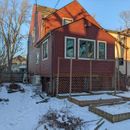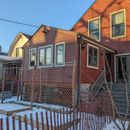Foam versus cellulose as a draft preventer in an exposed floor
We’ve been gradually doing insulation and HVAC retrofits on our 1890s vintage single family wood frame home in Chicago.
One area that remains problematic is a roughly 250 square foot extension added to the rear of the house about 30 years ago. It has an exposed floor, and in spite of me taking several steps to address it, that exposed floor remains somewhat cold and drafty. I’ll attach a few exterior photos to this post.
It’s my understanding from hanging out here over the years that a truly cold exposed floor is likely the result of air leakage, and that certainly matches up with my observations. The colder it gets, the colder this floor becomes and the more obvious the various little air leaks become.
My plan, for some time, has been to remove the plywood sheathing underneath the extension, have a flash coat of closed cell applied in the cavities to work into all the leaky nooks and crannies, then replace the sheathing and have dense pack cellulose used to fill the remainder of the space. (The floor joists are 2×10 and are filled with batt insulation, which I would remove as part of this project.)
I would likely have already followed through on this had my preferred insulation contractor not found it impossible to source HFO products this past summer. As I understand it, this was likely the result of ongoing supply chain issues combined with the fact that many non-Illinois states outlawed HFC foams starting in 2021.
If this HFO foam shortage continues into 2022, I’m tempted to contemplate omitting the spray foam entirely. The rough procedure would be to remove the sheathing and fiberglass, seal up any obvious or gross gaps with one part foam, then close it back up and rely on a good dense pack application to complete the draft-proofing.
I’m aware that I’m taking some risk with moisture in the summer. As I understand it, one of the benefits of cellulose in this case is that it has some capacity to absorb moisture seasonally as long as there is an appropriate period where it can dry out. Sitting here in mid January with cracked hands and lips, I can attest to the fact that Chicago generally has a lengthy dry and cold period.
I also _really_ want whatever I do to provide a significant air sealing improvement. Our past experience with cellulose in exterior walls has been quite positive. While it may not be air-tight, it’s a profound improvement over loose fitting fiberglass (which is what I believe is contributing to the draft in the extension).
One in-between option would be to use open-cell as the gap finder/filler and then follow up with cellulose as described above.
I’m curious what folks here think about this.
GBA Detail Library
A collection of one thousand construction details organized by climate and house part











Replies